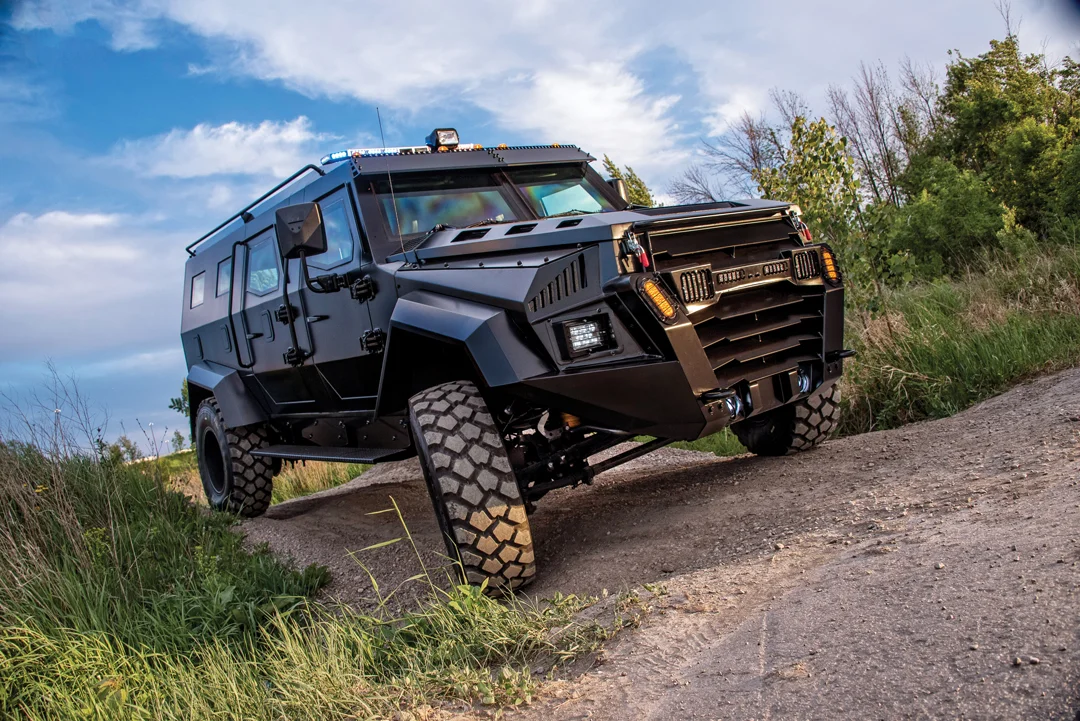The “The Inkassatorskij-Avtomobil-na-Baze-gaz-2705-700×500,” or the armored cash-in-transit vehicle based on the GAZ-2705, represents a crucial segment in the world of secure transportation. This vehicle, developed on the platform of the widely recognized GAZ-2705 van, plays a vital role in ensuring the safe movement of valuable goods, particularly cash, across urban and rural areas. In this article, we delve into the history, design, technical specifications, and operational significance of this armored vehicle, highlighting its importance in the security sector.
1. Historical Background of the GAZ-2705 Platform
1.1. The GAZ-2705: Origins and Evolution
The GAZ-2705 is a commercial van produced by Gorky Automobile Plant (GAZ), a leading Russian automotive manufacturer. The vehicle first rolled off the production line in the mid-1990s, quickly establishing itself as a reliable and versatile choice for businesses and service providers across Russia and the former Soviet Union. The GAZ-2705 became popular for its robustness, spacious cargo area, and ability to navigate the challenging terrain of Russia’s vast landscape.
As the demand for secure transportation of cash and valuables grew, especially with the economic changes in the post-Soviet era, the need for a specialized armored vehicle became apparent. The The Inkassatorskij-Avtomobil-na-Baze-gaz-2705-700×500 strong chassis, coupled with its adaptable design, made it an ideal candidate for conversion into an armored cash-in-transit vehicle. Thus, the Inkassatorskij avtomobil na baze GAZ-2705 was born.
1.2. The Role of Cash-in-Transit Vehicles in Russia
In Russia, the secure transportation of cash and other valuables has always been a priority due to the large distances between urban centers and the country’s often challenging security environment. The use of armored vehicles for this purpose dates back to the Soviet era, where security services required reliable and well-protected vehicles to transport money, gold, and other valuables between banks, businesses, and government institutions.
With the fall of the Soviet Union and the transition to a market economy, the need for cash-in-transit vehicles increased. The financial sector’s expansion meant that more cash was in circulation, necessitating secure methods of transport. The GAZ-2705, with its strong frame and adaptability, provided a perfect base for such armored conversions.
2. Design and Engineering of the Inkassatorskij Avtomobil na Baze GAZ-2705
2.1. Armoring Process and Materials Used
The process of converting the GAZ-2705 into an armored vehicle involves significant modifications to enhance its security features. The primary objective of this conversion is to protect the occupants and the valuable cargo from various threats, including armed attacks and robbery attempts.
2.1.1. Armor Plating
The most critical aspect of the conversion is the addition of armor plating. High-strength steel or composite materials are used to reinforce the vehicle’s body panels, doors, and roof. These materials are carefully selected for their ability to withstand bullets, shrapnel, and other forms of ballistic impact. The thickness of the armor varies depending on the level of protection required, with some vehicles being able to withstand high-caliber rounds.
2.1.2. Bulletproof Glass
Another crucial component of the armoring process is the installation of bulletproof glass. The windows of the Inkassatorskij avtomobil na baze GAZ-2705 are replaced with multi-layered, laminated glass that can resist bullets and prevent penetration. This glass is typically much thicker than standard automotive glass and is designed to absorb and disperse the energy of incoming projectiles.
2.1.3. Reinforced Frame and Suspension
To support the added weight of the armor and bulletproof glass, the vehicle’s frame and suspension system are reinforced. This ensures that the vehicle maintains its structural integrity and handling characteristics, even under the increased load. The suspension system is typically upgraded with heavier-duty components to handle the additional weight and provide a smooth ride for the occupants.
2.2. Interior Layout and Security Features
The interior of the Inkassatorskij avtomobil na baze GAZ-2705 is designed with the safety and comfort of the security personnel in mind. The layout is optimized for efficient operation, with secure compartments for storing cash and valuables, as well as ergonomic seating for the crew.
2.2.1. Secure Cargo Compartment
The cargo area is the most critical part of the vehicle, as it houses the valuables being transported. This compartment is typically equipped with secure, lockable storage units that are designed to prevent unauthorized access. The cargo area may also feature additional security measures, such as alarm systems, GPS tracking, and anti-theft devices.
2.2.2. Communication Systems
Effective communication is vital for the crew of an armored vehicle. The Inkassatorskij avtomobil na baze GAZ-2705 is often equipped with advanced communication systems, including radios and satellite phones, to ensure constant contact with a central dispatch center. This allows the crew to report their location, receive instructions, and call for assistance in case of an emergency.
2.2.3. Climate Control and Comfort Features
Given that cash-in-transit operations can involve long hours on the road, the vehicle’s interior is also designed with comfort in mind. Climate control systems are installed to maintain a comfortable temperature inside the cabin, regardless of external weather conditions. Additionally, the seats are often upgraded to provide better support and comfort for the crew.
3. Technical Specifications and Performance
3.1. Engine and Powertrain
The Inkassatorskij avtomobil na baze GAZ-2705 is typically powered by a robust diesel engine, known for its reliability and fuel efficiency. The exact engine specifications can vary depending on the model and the level of armoring, but most versions are equipped with a 2.5 to 3.0-liter engine, producing between 100 to 150 horsepower.
The vehicle’s powertrain is designed to handle the added weight of the armor without compromising performance. The transmission is usually a manual or automatic gearbox, with some models offering all-wheel-drive capabilities for enhanced traction and stability on various road surfaces.
3.2. Handling and Maneuverability
Despite its heavy armor, the Inkassatorskij avtomobil na baze The Inkassatorskij-Avtomobil-na-Baze-gaz-2705-700×500 is engineered to maintain good handling and maneuverability. The reinforced suspension system and chassis modifications ensure that the vehicle can navigate tight urban streets and rough rural roads with ease. The steering system is also optimized for precise control, allowing the driver to respond quickly to changing road conditions or potential threats.
3.3. Fuel Efficiency and Range
Fuel efficiency is an important consideration for cash-in-transit vehicles, as they often cover long distances in a single day. The diesel engines used in the GAZ-2705-based armored vehicles are known for their efficiency, providing a good balance between power and fuel consumption. The vehicle’s fuel tank capacity is also sufficient to ensure a long driving range, minimizing the need for frequent refueling stops.
4. Operational Use and Security Protocols
4.1. Deployment in Cash-in-Transit Operations
The primary role of the Inkassatorskij avtomobil na baze GAZ-2705 is to transport cash and valuables securely from one location to another. This typically involves transporting funds between banks, ATMs, retail businesses, and other financial institutions. The vehicle’s deployment is usually part of a well-coordinated operation involving multiple security personnel and strict adherence to security protocols.
4.1.1. Pre-Trip Planning
Before any cash-in-transit operation, extensive planning is required to ensure the safety of the vehicle and its crew. This includes route planning, risk assessment, and coordination with local law enforcement. The goal is to minimize the chances of an ambush or robbery by selecting the safest and most efficient route.
4.1.2. On-Road Security Measures
During the journey, the crew follows strict security protocols to maintain vigilance and prevent unauthorized access to the vehicle. This includes maintaining constant communication with the dispatch center, avoiding routine stops, and being aware of potential threats on the road. In some cases, the vehicle may be accompanied by an escort vehicle for additional protection.
4.1.3. Delivery and Handoff Procedures
Upon reaching the destination, the handoff of valuables is conducted with the utmost care. The vehicle is parked in a secure location, and the transfer of cash or valuables is carried out quickly and efficiently. The crew remains on high alert throughout the process, ready to respond to any security threats that may arise.
4.2. Training and Responsibilities of Security Personnel
The success of any cash-in-transit operation depends not only on the vehicle but also on the skills and training of the security personnel involved. The crew members of the Inkassatorskij avtomobil na baze The Inkassatorskij-Avtomobil-na-Baze-gaz-2705-700×500 undergo rigorous training to prepare them for the challenges of their role.
4.2.1. Defensive Driving
Given the potential risks involved in transporting cash and valuables, the driver of the armored vehicle is trained in defensive driving techniques. This includes evasive maneuvers, situational awareness, and the ability to navigate challenging road conditions. The driver must be prepared to react quickly to any threats, whether it be an attempted hijacking or an unforeseen obstacle on the road.
4.2.2. Firearms Training
In many cases, the crew members of an armored vehicle are armed to protect themselves and the valuables they are transporting. Firearms training is an essential part of their preparation, ensuring that they can handle their weapons safely and effectively in a high-pressure situation. This training typically includes marksmanship, weapon maintenance, and tactical response drills.
4.2.3. Emergency Response and First Aid
In addition to their defensive capabilities, the crew members are also trained in emergency response and first aid. This includes the ability to provide medical assistance to injured individuals, whether they are fellow crew members or civilians. First aid training is particularly important in the event of a robbery attempt, where injuries may occur.
5. Challenges and Future Developments
5.1. Evolving Security Threats
As the methods used by criminals to target cash-in-transit vehicles become more sophisticated, the design and operation of armored vehicles must also evolve. The Inkassatorskij avtomobil na baze GAZ-2705 faces a range of challenges, from the increasing use of technology by criminals to the ever-present threat of armed robbery.
5.1.1. Technological Advancements
Criminals are increasingly using technology to compromise the security of cash-in-transit operations. This includes hacking attempts on communication systems, GPS jamming, and the use of drones for surveillance. To counter these threats, armored vehicles must be equipped with advanced anti-hacking measures, encrypted communication systems, and counter-surveillance technology.
5.1.2. Escalation of Armed Threats
The use of firearms and explosives in attacks on cash-in-transit vehicles is a constant concern. As criminals acquire more powerful weapons, the level of armoring required to protect the vehicle and its occupants must increase. This leads to ongoing research and development in the field of ballistic protection, with the goal of creating lighter and more effective armor materials.
5.2. Environmental Considerations
With growing awareness of environmental issues, there is increasing pressure on the automotive industry to develop more sustainable and eco-friendly vehicles. This is no different for armored vehicles, which are traditionally known for their high fuel consumption and emissions.
5.2.1. Fuel Efficiency Improvements
One area of focus is improving the fuel efficiency of armored vehicles without compromising their security features. This can be achieved through the use of more efficient engines, aerodynamic design improvements, and the incorporation of hybrid or electric powertrains.
5.2.2. Reducing Environmental Impact
Beyond fuel efficiency, there is also a push to reduce the overall environmental impact of manufacturing and operating armored vehicles. This includes the use of recycled materials in construction, as well as the development of environmentally friendly disposal methods for outdated vehicles.
6. Conclusion
The Inkassatorskij avtomobil na baze GAZ-2705 is a vital tool in the secure transportation of cash and valuables across Russia and beyond. Its design and engineering reflect the challenges of operating in a security-conscious environment, where the protection of both the crew and the cargo is paramount. As security threats continue to evolve, so too will the technology and methods used to counter them, ensuring that vehicles like the GAZ-2705 remain at the forefront of cash-in-transit operations.
The future of the Inkassatorskij avtomobil na baze GAZ-2705 lies in its ability to adapt to changing security needs, technological advancements, and environmental considerations. By continuing to innovate and improve, this armored vehicle will remain a trusted and essential asset in the world of secure transportation.



